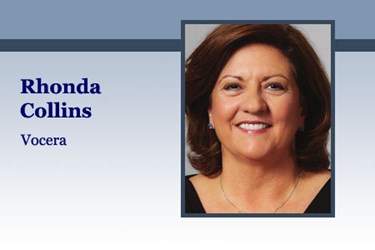National Health IT Week: Streamlining Patient Care by Minimizing Alarm Fatigue

By Rhonda Collins, Chief Nursing Officer, Vocera Communications
National Health IT Week is about recognizing the ways delivery of care is changing. Healthcare is in a period of transition that is changing how care is delivered. Health information is shared, quality is measured, reimbursements are dispersed, and patients are becoming engaged in their own. Today’s technology is advancing quickly and is a reliable tool to support these changes and advancements.
Nurses are at the forefront of transforming care with increased responsibility placed on them to achieve better patient outcomes. As nurses balance delivering care at more reasonable costs with providing chronic care management to an aging, sicker, and more diverse population, supporting technology must be finely tuned to meet their needs.
It is important to continue focusing efforts on bridging gaps in communication and coordination of patient care. Breakdowns in communication are today’s third-leading cause of death and accidental injury in hospitals, costing the “system approximately $12 billion every year.”
One way to address these challenges is to conduct a thorough assessment of clinical and communication workflow to determine the identified solutions for communication technology. Nurses should be able to instantly access the resources they need to make clinical decisions quickly. They should not need to leave the patient bedside to make a call or search for supplies.
Another major contributor to communication challenges in hospitals is alarm fatigue. Of the thousands of alarm signals that sound within a hospital every day, the Joint Commission estimates that 85 to 99 percent of those do not require immediate clinical intervention. As a result, care teams can become immune to alarm sounds, which can result in fatal consequences.
Patients can also become fatigued by constant alarms sounding. A recent survey of more than 200 hospitalized patients and their family members reported that alarms kept patients from sleeping, and made them feel anxious. Alarm management has become a top priority for hospitals, because if patients aren’t able to rest, they aren’t able to heal. The Joint Commission is requiring hospitals to establish policies by 2016 to ensure accountability for managing clinically relevant alarms, as well as educating staff about proper operation of these systems.
This National Health IT Week, it is important for hospitals to create a robust, integrated alarm management solution that can help clinicians quickly prioritize and respond to critical alarms. As nurses continue to take on increased responsibilities and hospitals face financial incentives related to the implementation of technology to improve patient safety and outcomes, more organizations will turn to secure and efficient mobile technologies.
Today, contextual notifications evidence can be sent directly to physicians’ and nurses’ devices of choice such as a hands-free wearable badge, smartphone, tablet or workstation. And with the right investment and an enterprise-wide communication strategy, hospitals can keep nurses, physicians and care teams in sync no matter where they are, ultimately delivering better care for the patient.
About The Author
Rhonda Collins, MSN, RN, is the Chief Nursing Officer for Vocera Communications. Vocera provides enterprise-class communication solutions that help care teams collaborate more efficiently by delivering the right information, to the right person, on the right device, at the right time, anywhere. Prior to Vocera, Rhonda practiced nursing for 15 years, serving as vice president at Fresenius Kabi, USA, CareFusion and Baylor University Medical Center. Rhonda can be reached at rcollins@vocera.com.
